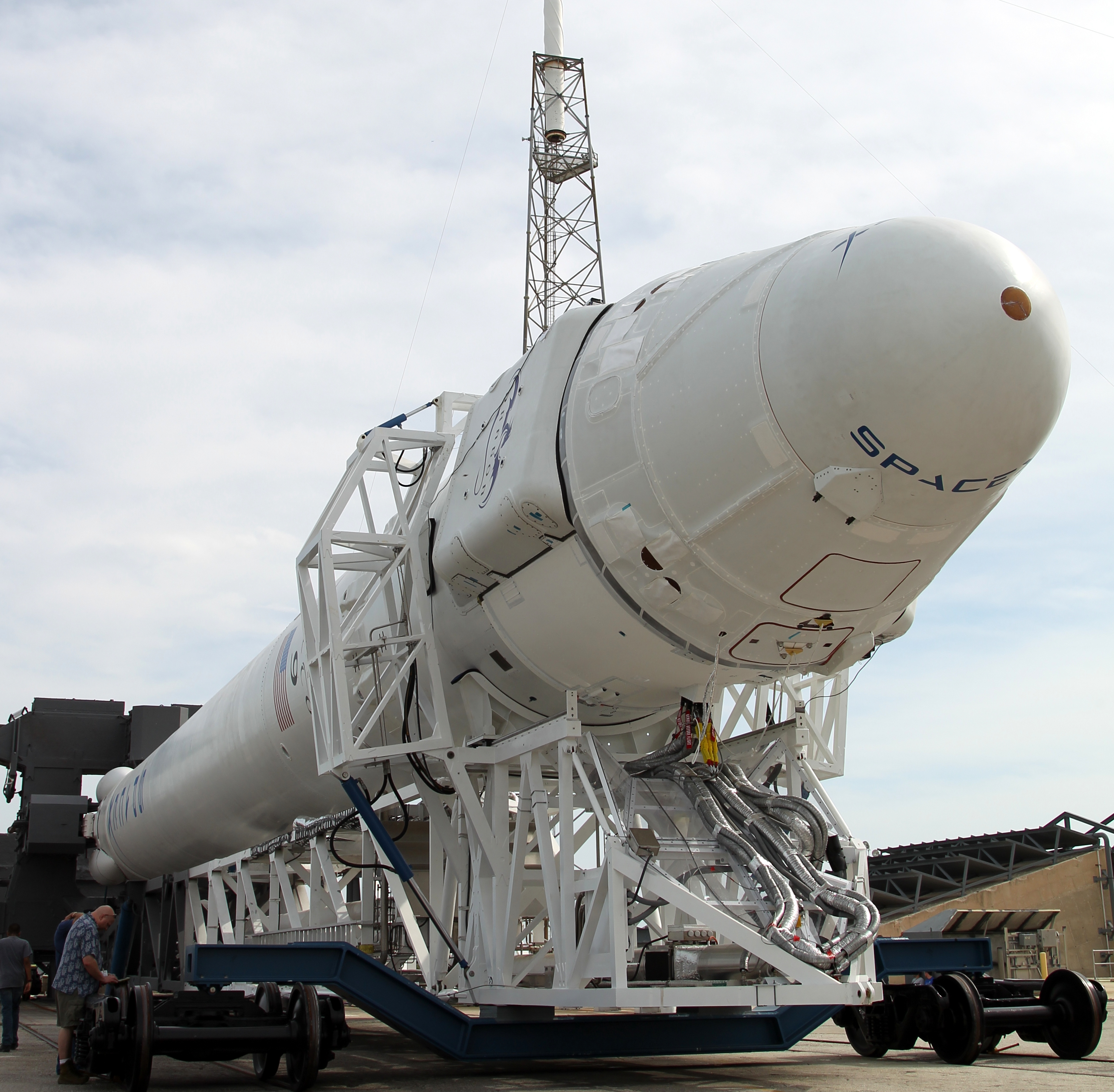SpaceX’s Falcon 9 rocket with a Dragon spacecraft is rolled out to the company’s launch pad in Cape Canaveral, Florida.
Credit: SpaceX
There will be more Dragons in space! The SpaceX Dragon’s next launch to the International Space Station has been scheduled for Sunday, October 7, 2012, NASA and SpaceX announced today. This will be the first of 12 contracted flights by SpaceX to resupply the space station and marks the second trip by a Dragon to the station, following a successful demonstration mission in May.
NASA said they have confirmed the status and readiness of the Falcon 9 rocket and its Dragon cargo spacecraft for the SpaceX CRS-1 mission, as well as the space station’s readiness to receive Dragon.
Dragon will be filled with about 450 kg (1,000 pounds) of supplies. This includes materials to support the 166 investigations planned for the station’s Expedition 33 crew, including 63 new science investigations. The Dragon will return about 330 kg (734 lbs) of scientific materials, including results from human research, biotechnology, materials and educational experiments, as well as about 230 kg (504 lbs) of space station hardware.
Materials being launched on Dragon will support experiments in plant cell biology, human biotechnology and various materials technology demonstrations, among others. One experiment, called Micro 6, will examine the effects of microgravity on the opportunistic yeast Candida albicans, which is present on all humans. Another experiment, called Resist Tubule, will evaluate how microgravity affects the growth of cell walls in a plant called Arabidopsis. About 50 percent of the energy expended by terrestrial-bound plants is dedicated to structural support to overcome gravity. Understanding how the genes that control this energy expenditure operate in microgravity could have implications for future genetically modified plants and food supply. Both Micro 6 and Resist Tubule will return with the Dragon at the end of its mission.
Expedition 33 Commander Sunita Williams of NASA and Aki Hoshide of the Japan Aerospace Exploration Agency will use the CanadArm2 to grapple the Dragon following its rendezvous with the station on Wednesday, Oct. 10. They will attach the Dragon to the Earth-facing port of the station’s Harmony module for a few weeks while crew members unload cargo and load experiment samples for return to Earth.
Dragon is scheduled to return in late October, and splash down via parachute in the Pacific Ocean off the coast of southern California.


Amazing what innovative, efficient, spirited private enterprise can do compared to bloated, red-tape, pork driven Federal Govt..
NASA wasted $20 billion on it’s failed/cancelled Constellation..
While SpaceX produced far superior boosters/capsule for only $300 million.
That would be right…and ATK still
think they can compete with their Ares I retread.
Soon the Dragon will become man-rated with its inaugural flight shortly afterwards, talk about progress. NASA’s Orion won’t make its inaugural flight until well into 2014. The Dragon could make a lunar mission then.NASA still speaks of proposed missions while Space X produces.For the money,effort and the future, Space X is the best bet.
Hmmm.. “The Progress Cargo Module — which is similar in construction to the
Soyuz Orbital Module — can carry up to 1,700 kilograms (3,748 pounds)
of supplies to the Space Station in a pressurized volume of about 6
cubic meters (212 cubic feet).” The Dragon can carry 6,000 kg / 13,228 lb (launch). So why are they only taking 450kg (1,000lbs) of supplies? Other cargo on board? I took a look around and couldn’t find a mission manifest…..?
very strange, only 450kg of cargo. It’s kinda a silly to spend so many bucks for so little bang.
It has the unique ability of all other spacecraft out there right now of being able to return large amounts of cargo to earth. The Progress burns up, the Soyuz doesnt have room, and the ATVs burn up.
There will be
secondary payloads. The 150 kg (330 lb) prototype second-generation
Orbcomm satellite Orbcomm-G2 is also due to go up on this flight
plus there’s the additional fuel requirement for delivering this
satellite to an orbit some distance away from the ISS.
Source:
http://en.wikipedia.org/wiki/CRS_SpX-1
http://www.spaceflight101.com/dragon-crs-1-mission-updates.html
(last paragraph)
The Dragon can carry 6 mt but the current launcher can’t put both Dragon and that mass in LEO, SpaceX is still learning to minimize fuel consumption to reach ISS so have largish fuel reserves and NASA is still testing out the mass capacity so loads smallish cargo masses.
Other reasons for small up mass is as here a need for down mass rather. Or they can have volume limited loads.
The SpX-3 launch (after SpX1 & 2) should be with the longer Falcon 9 v1.1 with larger engines, which is supposed to ultimately push the LEO up mass to ~ 13 mt from Cape Canaveral. A dry mass Dragon is ~ 4 mt, so if they can get away with ~ 3 mt fuel they can make ~ 6 mt.
SpaceX aren’t telling how much the Falcon’s launch and the Dragon’s mass with fuel; at least not yet.
Hey Torbjörn, have you seen the latest (posted today) video clip on the reusable Falcon
demonstrator: The Grassshoper?
Here is the first little hop…